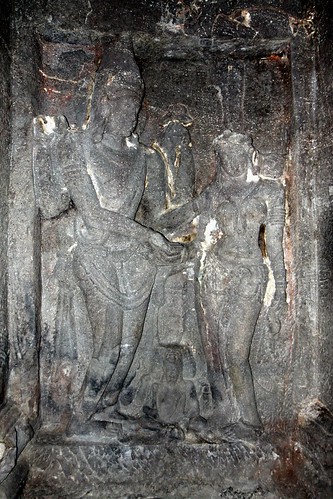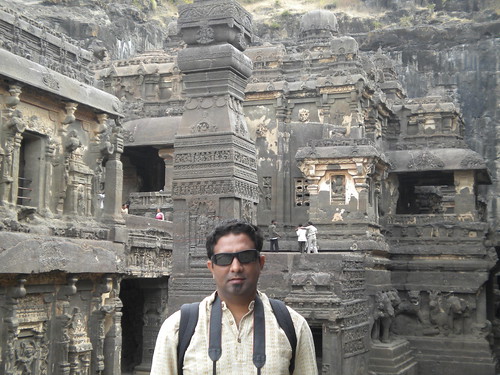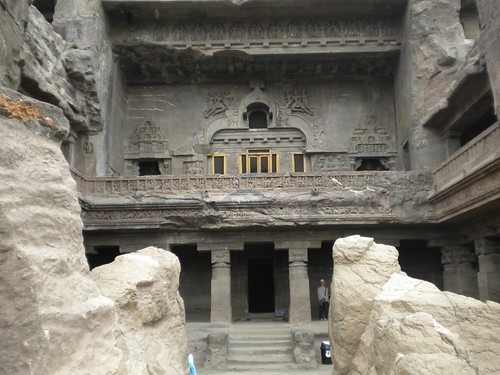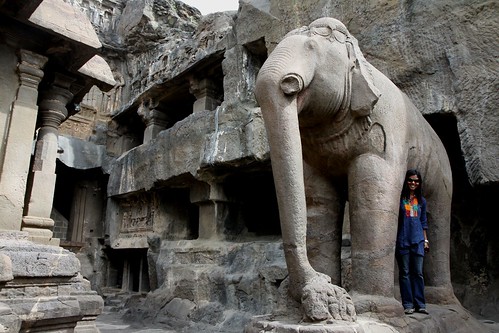Aurangabad’s MTDC Resort has state-approved travel agencies on-site that offer guided tours to the World Heritage Sites of Ellora and Ajanta. This was one of the reasons we decided to stay here. Without a car, getting to either of these places would have been a pain. Moreover, since the tours include a guide, we figured it would be a very convenient (and cheap!) option. But things didn’t really turn out as we planned¦
At the hotel we found that the Ellora tour included a tour of Aurangabad, Daulatabad Fort and Khuldabad (Aurangzeb’s tomb) along with Ellora. This seemed to be a little too much to do in one day! Daulatabad and Khuldabad are on the way to Ellora so stopping there made sense but the tour of the city didn’t. This is why we hired a private taxi to tour the city on our own yesterday and also booked the same guy to take us to Ellora today. One thing about this MTDC hotel – in spite of the state-approved travel agencies, there are many taxi guys standing around trying to grab customers. We were surprised that this was being allowed by the hotel management. Later, even more strangely, the hotel manager personally brought a taxi driver to us recommending his taxi for touring Ellora and Ajanta. It all seemed very fishy!
We started around 9am from our hotel and got to Ellora in less than an hour; it’s just about 30kms away. As our car pulled up to the main, gated entrance, we were surprised to see many tourist buses and private cars in the parking area – didn’t expect this much traffic on a weekday ! After buying tickets near the entrance, we asked for a guide and a young chap walked up to us presenting his card that stated him to be an official, state-approved guide of Ellora. He later told us that there are only a limited number of guides and they have to offer their services on a rotation basis. So, basically, we cannot choose a guide; the next person on rotation gets assigned to us automatically! This is a little scary especially if one gets stuck with someone they don’t like. Luckily for us, our chap turned out to be nice; he spoke well and was quite knowledgeable.
These caves were carved out of a 2km long cliff-face, running north-south. The Jain temples are at the northern end, the Hindu caves and temples in the center and finally the Buddhist ones at the southern end. The government has done a good job of maintaining this area by laying stone pathways between the caves with large, green spaces near the main entrance – it looked quite impressive!
Our tour of Ellora started with the Hindu group and its most celebrated part – Cave 16 or  the magnificent Kailasa temple. Cut out of a huge mass of rock in the 8th century and commissioned by King Krishna I of the Rashtrakuta dynasty, Kailasa temple is considered to be the very best of ancient Indian architecture. It’s said that 200,000 tons of rock was laboriously chiseled out of the rock-face as the temple took shape. The magnitude of the work is truly unimaginable! We entered the complex through a two-storied, walled entrance in front of the temple. It has some exquisite sculptures, the best being that of ‘Mahishasuramardini’ (Durga killing the demon Mahishasur). Pillared hallways, cut into the cliff, surround the temple on the other 3 sides.
the magnificent Kailasa temple. Cut out of a huge mass of rock in the 8th century and commissioned by King Krishna I of the Rashtrakuta dynasty, Kailasa temple is considered to be the very best of ancient Indian architecture. It’s said that 200,000 tons of rock was laboriously chiseled out of the rock-face as the temple took shape. The magnitude of the work is truly unimaginable! We entered the complex through a two-storied, walled entrance in front of the temple. It has some exquisite sculptures, the best being that of ‘Mahishasuramardini’ (Durga killing the demon Mahishasur). Pillared hallways, cut into the cliff, surround the temple on the other 3 sides.
Since Lord Shiva is the main deity in the temple, the hallways have some fantastic sculptures of the Lord with his consort, Parvati. Our guide did a great job explaining these to us and out of them all, 2 sculptures won my heart! One of them depicts the marriage of Lord Shiva with a very coy Parvati. She is shown to be beautifully adorned with jewelry and hair accessories. However, her left leg is missing an anklet and the guide explained that the artist wanted to portray the state of Parvati’s heart as she hurriedly dressed for the event, forgetting an anklet in the process! The other sculpture depicts the couple playing a game of Chaupar, which Parvati seems to have won. She has a smug expression on her face while Lord Shiva looks annoyed and is shown with one arm on Parvati’s shoulder stopping her from walking away and asking her for one more game to get even – priceless !
them all, 2 sculptures won my heart! One of them depicts the marriage of Lord Shiva with a very coy Parvati. She is shown to be beautifully adorned with jewelry and hair accessories. However, her left leg is missing an anklet and the guide explained that the artist wanted to portray the state of Parvati’s heart as she hurriedly dressed for the event, forgetting an anklet in the process! The other sculpture depicts the couple playing a game of Chaupar, which Parvati seems to have won. She has a smug expression on her face while Lord Shiva looks annoyed and is shown with one arm on Parvati’s shoulder stopping her from walking away and asking her for one more game to get even – priceless !
On either side of the temple are two beautifully carved Dhvajasthambas (pillars with flagstaff). Besides them are ruins of large stone elephants, which must have looked regal back in the day. The temple, itself, has some fantastic carvings including 2 intricately carved panels depicting scenes from the Ramayana and Mahabharata. Another popular sculpture is that of Ravana flaunting his strength by lifting and shaking Mt. Kailasa. It shows all the Devi, Devtas and aides running for cover but Lord Shiva sits unperturbed. He is shown flexing his toe, which stops the shaking and crushes Ravana’s pride.
Since the temple is still used as a prayer chamber, we had to remove our footwear before  entering it. Inside the inner sanctum, which is surprisingly unadorned with carvings, is a large stone Lingam. We paid our respects and headed back out quickly as people started crowding the place. As we were guided out of the temple, we realized that it is connected to the 2-storied front wall through a stone passageway. Our guide explained that viewed aerially, the temple looks like a massive stone chariot with the front wall as the yoke ! A true masterpiece! We were taken to a couple of vantage points on the upper storey of the front wall to get some great shots of the entire complex.
entering it. Inside the inner sanctum, which is surprisingly unadorned with carvings, is a large stone Lingam. We paid our respects and headed back out quickly as people started crowding the place. As we were guided out of the temple, we realized that it is connected to the 2-storied front wall through a stone passageway. Our guide explained that viewed aerially, the temple looks like a massive stone chariot with the front wall as the yoke ! A true masterpiece! We were taken to a couple of vantage points on the upper storey of the front wall to get some great shots of the entire complex.
From here we walked south towards the Buddhist caves. There are 12 of them, 11 of which are  Viharas (monasteries) while one, Cave 10, is a Chaitya (assembly hall). Our guide took us to Cave 10 first. It has an impressive facade fronted by a small courtyard. The pillared entry porch has a decorative, arched window on the upper storey. This assembly hall is considered to be the finest in India with its enormous figure of the teaching Buddha! Our guide stood by the side of this sculpture, cupped his mouth and sang out a lovely prayer, which boomed out across the hall giving us Goosebumps! These caves have the best acoustics ever!
Viharas (monasteries) while one, Cave 10, is a Chaitya (assembly hall). Our guide took us to Cave 10 first. It has an impressive facade fronted by a small courtyard. The pillared entry porch has a decorative, arched window on the upper storey. This assembly hall is considered to be the finest in India with its enormous figure of the teaching Buddha! Our guide stood by the side of this sculpture, cupped his mouth and sang out a lovely prayer, which boomed out across the hall giving us Goosebumps! These caves have the best acoustics ever!
Our next stop was Cave 12, a 3-storied Vihara with the top floor having the best sculptures within the Buddhist group. Our guide showed us a couple of small stone cells, where the only furniture was a stone bed carved out of the wall. On the top floor, there is a large sculpture of Buddha flanked by sculptures of his six previous births – these were quite stunning! Here we saw an elderly lady ask our guide something in Marathi. He later explained that she was a follower of the Mahanubhav sect, which was propagated by a 13th century saint, Chakradhar Swami, who is known to have lived in this cave. Devotees come here to pay their respects to the saint’s memory by touching their forehead to the spots in the cave where he is said to have sat or prayed. Our guide showed us these spots; they have a smoother and darker finish than the other areas of the caves¦
We drove to the Jain temples at the northern end; a couple of kilometers were too far to walk in  the heat and it saved time. We were guided to Cave 32 and as soon as I stepped into its courtyard, I recognized the large stone elephant to the right of the entrance. I have visited Ellora years ago as a kid with my family. I remember climbing atop the stone platform on which the elephant stood, along with my siblings, while my father took pictures. Just for old times sake I clambered on to the stone platform and got Madhu to click a picture. As soon as he took the shot, our guide softly asked me to get off the platform; visitors are no longer allowed to clamber on to the monuments! What was I thinking! I was completely embarrassed ! I had gotten a little carried away by my childhood memories of the place. Thank God I didn’t get yelled at by some security guard !
the heat and it saved time. We were guided to Cave 32 and as soon as I stepped into its courtyard, I recognized the large stone elephant to the right of the entrance. I have visited Ellora years ago as a kid with my family. I remember climbing atop the stone platform on which the elephant stood, along with my siblings, while my father took pictures. Just for old times sake I clambered on to the stone platform and got Madhu to click a picture. As soon as he took the shot, our guide softly asked me to get off the platform; visitors are no longer allowed to clamber on to the monuments! What was I thinking! I was completely embarrassed ! I had gotten a little carried away by my childhood memories of the place. Thank God I didn’t get yelled at by some security guard !
Cave 32 is a two-storied structure with some wonderful sculptures of the Mahavira.  The upper floor, which is an assembly hall, is called the Indra Sabha because of its exquisite and detailed carvings. We were absolutely enthralled by this pillared hall; Madhu found it to be the best he’s seen at Ellora. Inside the shrine is a seated image of Mahavira while the walls have sculptures of other Jain Tirthankars. A small passageway at the corner of the floor connects Cave 32 to the adjoining Cave 33. This, apparently, was cut through the wall connecting the two much later and is not part of the original construction of the caves. Through this passageway, we entered the upper floor of Cave 33, which, though quite ornate, was not as detailed as the previous cave. This hall is called the Jagannath Sabha. Here a family approached our guide and asked him if he would guide them around Ellora after he’s finished with our tour. Although, he would have loved to get another job right away, our guide had to refuse and requested them to go back to the main entrance where they would be assigned the next available guide on rotation. The family left dejected; going back to the entrance would be a chore.
The upper floor, which is an assembly hall, is called the Indra Sabha because of its exquisite and detailed carvings. We were absolutely enthralled by this pillared hall; Madhu found it to be the best he’s seen at Ellora. Inside the shrine is a seated image of Mahavira while the walls have sculptures of other Jain Tirthankars. A small passageway at the corner of the floor connects Cave 32 to the adjoining Cave 33. This, apparently, was cut through the wall connecting the two much later and is not part of the original construction of the caves. Through this passageway, we entered the upper floor of Cave 33, which, though quite ornate, was not as detailed as the previous cave. This hall is called the Jagannath Sabha. Here a family approached our guide and asked him if he would guide them around Ellora after he’s finished with our tour. Although, he would have loved to get another job right away, our guide had to refuse and requested them to go back to the main entrance where they would be assigned the next available guide on rotation. The family left dejected; going back to the entrance would be a chore.
Our tour of Ellora was completed with Cave 33. We had taken approximately 2 and ½ hours to see four caves and the great Kailasa temple where we had spent an hour. The guides charge Rs.600 for their services and it is money well-spent. There are, in total, 34 caves at Ellora but there’s no way one can see them all in a single visit. Not only would it be physically exerting, it would also be a bit boring as many of the caves are said to have repetitive images and design. This brief but detailed visit was absolutely perfect!


No comments yet.